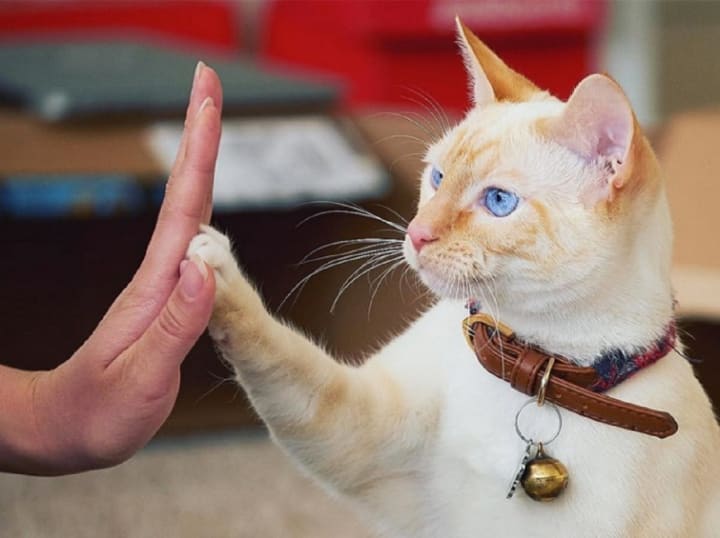Learning Cat Tricks
Tricks For Intelligent Cats

Preparation, Attention, Now – Tricks!
To train your cat, you must prepare thoroughly.
Routine is crucial at the beginning, which entails practicing in the same spot and with no distractions. Your four-legged pal can concentrate on his activity best if there is no background noise, including music.
Prepare a tasty reward so you may encourage each workout step positively with it. In order to provide your cat with a share of the daily diet, it can also be a wonderful dry food.
Although you can train cats of any age, extremely young kittens occasionally struggle to focus on the tasks, and training often becomes simpler at around a year old. Our training is based on the principle of classical conditioning, which holds that cats learn new behaviors when they are rewarded.
The majority of cats already display conditioned responses in daily life: they open a cupboard where delectable cat treats may be stored as a stock. When your cat hears the closet door open, she runs to it eager for some tasty treats. This fundamental idea is also used while teaching a cat new tricks.
Learning Commands:
A few more comments regarding "Learning Commands" before we get started. Once your cat has learned a trick, you can use a command. Give your cat the proper command if you know through training that she will exhibit the desired behavior within a short period of time. You can offer verbal instruction and then always focus on the same accent, or you can, for instance, always move your hand in the same way.
Practice until the cat exhibits the desired behavior "on command," but keep in mind that having fun should always come first! The key is to only reward your cat when it performs the "on command" trick, not when it does it on its own, once it has definitely mastered the command.
Entice Your Cat With A Scent!
This "trick" may not seem very impressive at first, but it serves as the cornerstone of our training since it combines a tasty reward with our positive reinforcement method of sound.
This can sound like a clicker or like a brief "plop" made with your lips, but it needs to be a consistent sound so that the cat can learn to recognize it.
How do we train our animal companions? She will probably leave everything if you sit in front of it and toss your cat's favorite treat, such as one of the many cat treats! Your tiger is eager for rewards, so make a sound signal at the same time.
Continue doing this until the cat understands, "This sound indicates that I get a treat!" It is crucial for your cat to internalize this type of training because it is always utilized in the beginning.
“Come!”
If you have a cat, you probably already know that she will respond to your call only if she is compelled to or if she can smell a full dish of juicy leftovers. If your cat is motivated to learn, you can significantly boost your degree of success with a little instruction.
Your likelihood of success may be lowered if you collapse exhausted and asleep on the radiator. Sit in front of your cat and hold up a goodie to demonstrate the "Come!" command. The order must always be the same while calling the cat to you, such as "Come!" You should also issue the command upon receiving one of the delectable treats.
The first exercise is complete when you sit down and repeat this up to ten times.
Tip: Throw the tasty piece two meters away and then alter the distance again if your tiger cub is following you to get to the tasty pieces faster.
You can just say, "Come!" at one of the upcoming training. And then hide the treat; if the cat appears, give her the reward she desires; otherwise, you must take a step back.
A clicker sound signal is not required for this activity, but you can use one in addition to reward your cat for each correct movement with an amplifying sound.
Command–Up!
The majority of cats will instantly sit on their hind legs to enjoy a small "prey" so keep a treat over their heads. Use a clicker or a well-known boost to encourage your cat to move upwards when she does so.
The key is to only praise attempts in which the cat offers you its paws; otherwise, you risk receiving scratches as a result of this trick in the future.
You can eventually do the following, depending on the intended outcome: for instance, your cat should only hold that position for a little period of time; whenever she holds it for a longer period of time, always give her an additional treat.
Last but not least, you can link the command to the desired action, such as "Ask" or "Up."

“Sit Down!”
The instructions "Sit!" and "In Place" aren't just for dogs, though!
Hold a treat or engaging toy over your cat's head while using the "Sit!" command; when the cat notices, pull the object back a little. Most cats will immediately sit down to concentrate on their "prey."
Reward such behavior right away with a pleasant and motivating reward. Another approach is to always give the cat a treat or a beep when it unintentionally assumes the "Sit" position. However, keep in mind that this strategy only works if you give your cat a treat right away after it sits, not if you have to run to the kitchen first.
Always have the reward nearby, or use it in settings where you know your cat will shortly take a seat. This technique, known as "capturing," actively reinforces the desired behavior in daily life. 'Sit down!' is an excellent starting point for other tricks!
Giving paws
The instruction "Give a paw" is undoubtedly one of the most popular tricks.
What can we do, though, to make our cat more appetizing? She is in the ideal position to immediately assume the "Sit" position because she is in it.
Put the cat in front of you, put your hand on the ground, and beep or treat the cat if it shows any interest in your hand. The cat is encouraged to sniff your hand in the following exercise, and if she does so confidently after a few repetitions, you advance to the next step, where the cat must now give you its paw before you can give it a treat. To do this, simply extend your hand in front of the cat as you normally would.
The time is now for rewarding behavior because if she doesn't get the treat after sniffing, she'll experiment and eventually touch your palm with her paw.
Extend the reward period such that "Give a Paw" will now be rewarded after two or three seconds, and then slowly raise your hand. You can use the command if your clever friend learns how to do it.

Give Me Five
Your cat should already be able to perform the "Sit" and "Give a paw" feats in order to perform the well-known "Give me five!" trick.
Then, it takes just a few simple steps to get the desired "Give five with a paw": using the "Give a paw" method, simply raise your hand higher and higher until it is in the "Give five" position.
Step-by-step, beep and treat your canine training partner as they progress along the path.
Go back to "Give a Paw" if the cat becomes agitated, then proceed slowly once more. Once your cat has mastered the trick, you can use an extended hand or simply say the order.
“In Place!”
The command "In place!" can be taught to your cat in a variety of ways.
So, for instance, you could hold a treat in your hand, place it lightly on the floor, and wait for your cat to lie down in front of it. Then, you could give it a reward at the first indication of descent and lure it to a lying position at all times.
With the customary beep, encourage the desired behavior. You can employ the instruction if the cat understands what is expected of it; a hand motion pointing down is particularly suitable in this situation.
Alternatively to the "Place!" Command (see "Sit!"), you can use the "Capturing!" command, for instance, if you know your pet will join you before a leisurely evening on the couch.
Rolling
The phrase "In place!" serves as the trick's entry point.
If your cat is sleeping in front of you, move your hand just a little bit over it so that it can turn on its back and follow your hand with its gaze.
Instead of holding a treat in that hand, give the cat a small treat and a sound cue for every movement they make in the appropriate direction, up until they play the entire part.
Always practice your part from the same side! Your cat may become confused at first if you train individually for a trick on each side if you want to do it on both. If your cat has mastered a trick, you can command it verbally or with a hand gesture.

Jumping
Hold the hoop close to the ground in front of the cat as it stands in front of you and tempt it through with a reward.
If the cat is initially a little dubious, have patience. If you are confident that you can fit through the hoops, raise them gradually until the cat must jump to pass through.
Take a further step back if the cat goes underneath it.
Pay close attention to whether the floor is slick and only hold the hoop up high enough for your tiny pal to jump with no apparent effort.
Tip: As an alternative, your cat may jump using your extended hand. You can lift the hoop or arm or give a command like "Hop!" if the cat responds well to these tricks.
A few more tips for the end: In any cat training, having fun is always the priority. It is recommended to engage in brief training sessions with your cat every day or every other day. A fixed number of rewards can also be established for each training series.
Never forget: time is of importance; immediately praise desired behavior! Even if it necessitates going back a step, make sure the cat feels accomplished at the end of each exercise.
You should also move back if your training partner licks his fur while exercising because this action, as well as others like it, causes a change in activity and indicates that your pet is unsure of what is expected of him.
Regularly practice the known tricks to keep your cat from forgetting them. The skills acquired may undoubtedly be applied to daily life: Is the cat waiting patiently for a tasty meal? After that, offer her a full bowl after letting her perform a quick trick.





Comments
There are no comments for this story
Be the first to respond and start the conversation.